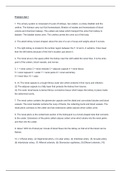Thompson River University (TRU ) • Nursing
Latest uploads for Nursing at Thompson River University (TRU ). Looking for Nursing notes at Thompson River University (TRU )? We have lots of notes, study guides and study notes available for Nursing at Thompson River University (TRU ).
-
75
- 0
-
1
Courses Nursing at Thompson River University (TRU )
Notes available for the following courses of Nursing at Thompson River University (TRU )
Latest notes & summaries Thompson River University (TRU ) • Nursing
Problem Set 1: 1. The function of the nervous system is to integrate and control the other body systems. Explain how the nervous system does this. The nervous system receives and processes information and sends out signals to the muscle and glands to elicit an appropriate response. In this way the nervous system integrates and controls the other systems of the human body 2. List the 2 parts of the central nervous system. brain and spinal cord 3. How are the parts of the central nervous syst...
Advanced Phys Study Guide Exam 3 1. Where do blood cells arise from during embryonic development? • yolk sac in vertebrate embryo produce stem cells that colonize fetal bone marrow, liver, spleen & thymus • liver stops producing blood cells at birth, but spleen and thymus remain involved with WBC production • red bone marrow (myeloid hematopoiesis) produces RBCs, WBCs and platelets 2. Role of hemacytoblasts (stem cells)? What are the major cell lines they can follow to mature into b...
A&P Module 03 Case Study • Question 1 1 out of 1 points Alyssa is a 74-year-old female patient who presents to her primary care provider for a routine physical. She states that she feels “quite healthy” and has no complaints other than mild back pain. She has a family history of various cancers, diabetes, and osteoporosis, so she knows that it is important to stay active and keep up with screenings and annual physical exams. Alyssa’s provider finds that she has lost 10 pounds sinc...
Question 1 The Female Reproductive System 1. The female reproductive system includes what internal organs? Internal organs: the ovaries, the oviducts (fallopian or uterine tubes), the uterus, and the vagina. 2. What is ovulation? How often does it occur? The release of a mature egg; occurs approximately every 28 days. 3. What is the ovarian cycle? An egg is released from the ovarian follicle. 4. What does the ovarian follicle become after ovulation? The corpus luteum 5. What is...
Hesi A2 anatomy study guide • Mitosis is necessary for growth and repair. In this process the DNA is duplicated and distributed evenly to two daughter cells. • Meiosis is the special cell division that takes place in the gonads that is the ovaries and testes. In the process of meiosis, the chromosome number is reduced from 46 to 23 so when the egg and the sperm unite in fertilization the zygote will have the correct number of chromosomes. • The skin consists of two layers: epidermis ...
1. A charge nurse has heard one of the staff RN’s complaining about her …. Problem and negotiate a better schedule for both of the,. Assertive 2. The nurse is caring for a client who is a Native American Indian.. The client is wearing a medicine bag ….. advocate for the client’s spiritual needs? Check with the surgeon about placing the medicine bag in a clean bag, taped to the … 3. According to expert nursing theorists, Nursing does not meet all criteria for the… (SATA) Rai...
Chapter 1 1) Julia was diagnosed with bone cancer at the age of six. It was necessary for doctors to amputate her right leg below the knee. According to current terminology, Julia is A) challenged B) impaired C) at-risk D) handicapped 2) Carlos is a high school student in a wheelchair. He participates in advanced placement math and science classes and does well in other subjects. He feels awkward in PE because he is unable to fully participate in sports like basketball. ...
Chapter 2 study guide (complete) 1. Be able to describe the structure of an atom Elements (Atoms) are the building blocks of matter 2. Be able to define the atomic number, the mass number of an element The atomic number (number of protons) gives the an Element (atom) its identity. The mass number is the amount of protons and electrons added up. 3. Be able to describe which number determines the nature of an element The atomic number 0 4. Be able to name the four elements that are...
Chapter 1 1) Julia was diagnosed with bone cancer at the age of six. It was necessary for doctors to amputate her right leg below the knee. According to current terminology, Julia is A) challenged B) impaired C) at-risk D) handicapped 2) Carlos is a high school student in a wheelchair. He participates in advanced placement math and science classes and does well in other subjects. He feels awkward in PE because he is unable to fully participate in sports like basketball. ...
Problem Set 1 1. The urinary system is composed of a pair of kidneys, two ureters, a urinary bladder and the urethra. The kidneys carry out fluid homeostasis, filtration of wastes and homeostasis of blood volume and chemical makeup. The ureters are tubes which transport the urine from kidney to bladder. The bladder stores urine. The urethra carries the urine out of the body. 2. The adult kidney is bean shaped, about the size of a can of soup and weighs about 5 ounces. 3. The right kidney is l...










